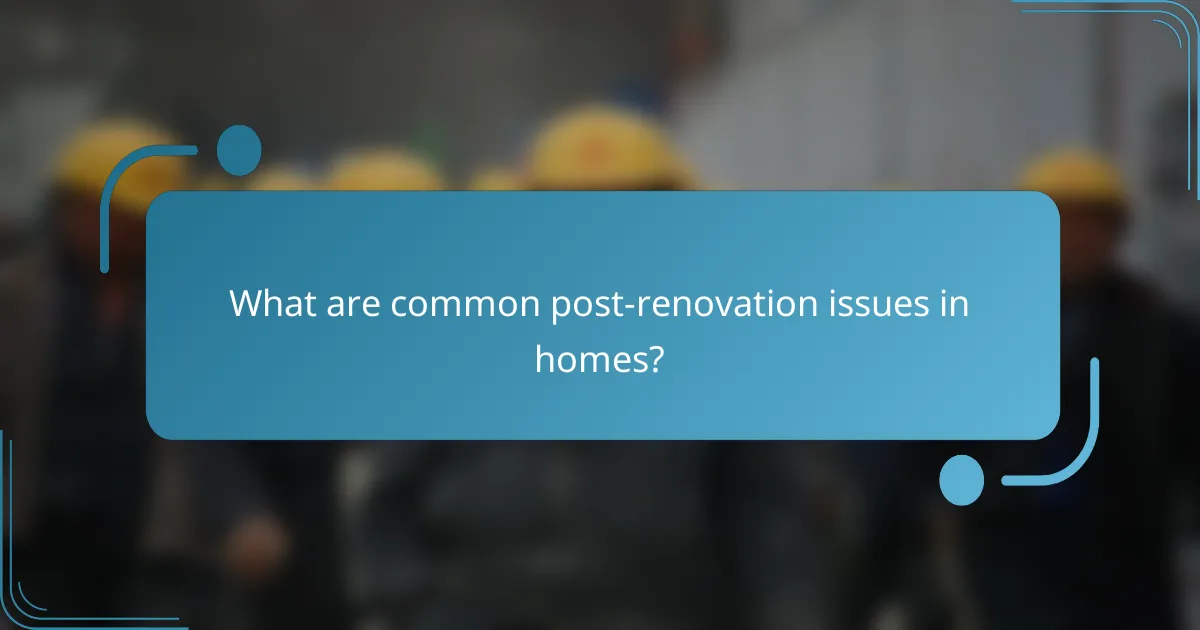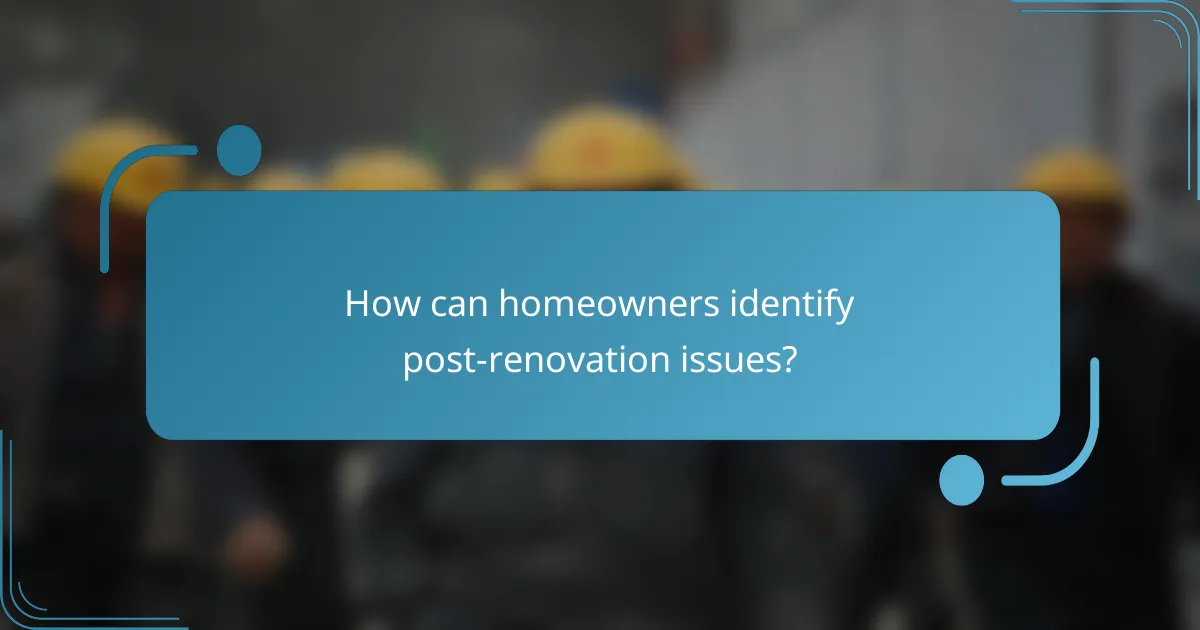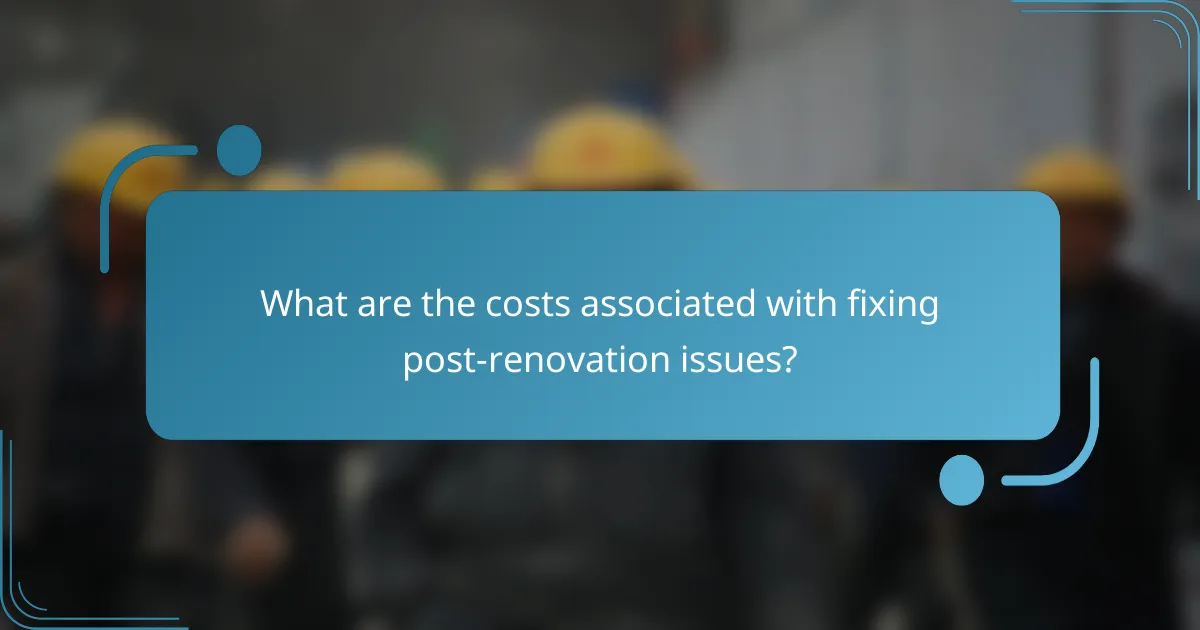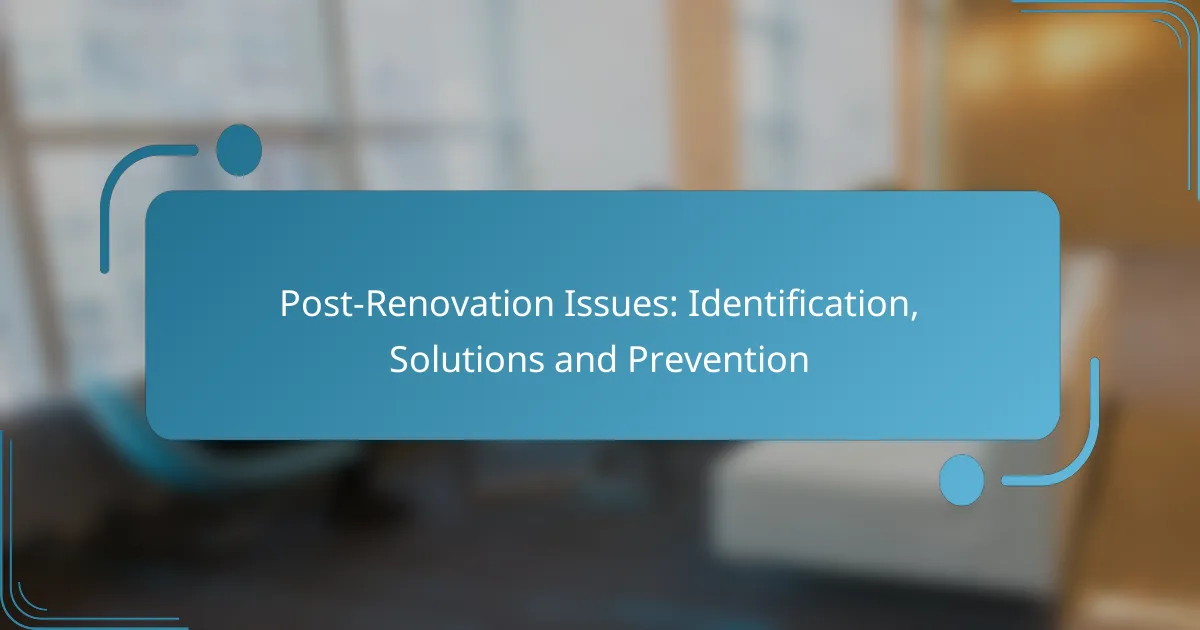Post-renovation issues can significantly impact the integrity and comfort of a home, often manifesting as water damage, structural concerns, or inadequate insulation. Early identification through thorough inspections is crucial for homeowners to mitigate these problems and avoid costly repairs. Implementing effective solutions, such as waterproofing and electrical upgrades, can enhance the durability and safety of newly renovated spaces.

What are common post-renovation issues in homes?
Post-renovation issues in homes often include water damage, structural problems, electrical issues, insufficient insulation, and improper ventilation. Identifying these problems early can help homeowners address them effectively and prevent further complications.
Water damage
Water damage is a frequent concern after renovations, especially if plumbing or roofing work was involved. Homeowners should check for leaks, damp spots, or mold growth, which can indicate underlying issues.
To prevent water damage, ensure that all plumbing connections are secure and that roofing materials are properly installed. Regular inspections can help catch any potential problems before they escalate.
Structural problems
Structural problems may arise if renovations compromise the integrity of load-bearing walls or foundations. Signs include cracks in walls, uneven floors, or doors that stick.
Consulting a structural engineer during renovations can help identify potential risks. If issues are detected, timely repairs are essential to maintain safety and stability.
Electrical issues
Electrical issues can occur when new fixtures or outlets are added without proper planning. Look for flickering lights, tripped breakers, or outlets that do not work, as these may signal unsafe wiring practices.
Always hire a licensed electrician for electrical work. Adhering to local codes and regulations ensures safety and functionality in the electrical system.
Insufficient insulation
Insufficient insulation can lead to energy inefficiency and uncomfortable indoor temperatures. After renovations, check areas like attics and walls to ensure they are properly insulated.
Consider using insulation materials that meet local energy efficiency standards. Proper insulation can significantly reduce heating and cooling costs over time.
Improper ventilation
Improper ventilation can cause moisture buildup and poor air quality, leading to health issues. Signs of inadequate ventilation include condensation on windows and persistent odors.
Installing exhaust fans in kitchens and bathrooms can improve air circulation. Regularly checking and maintaining ventilation systems helps ensure a healthy living environment.

How can homeowners identify post-renovation issues?
Homeowners can identify post-renovation issues by conducting thorough inspections and utilizing checklists to ensure everything is functioning as intended. Early detection of problems can save time and money, making it essential to be vigilant after any renovation work.
Visual inspections
Visual inspections are a straightforward way for homeowners to spot potential issues after renovations. Look for signs of water damage, such as stains on walls or ceilings, and check for cracks in the foundation or walls. Pay attention to the condition of finishes, including paint, flooring, and fixtures.
Inspecting the exterior is equally important. Check for proper drainage around the foundation, and ensure that gutters and downspouts are functioning correctly. Look for any gaps or misalignments in windows and doors that could indicate structural issues.
Professional assessments
Engaging professionals for assessments can provide a more comprehensive evaluation of post-renovation conditions. Home inspectors or contractors can identify hidden problems that may not be visible to the untrained eye, such as electrical or plumbing issues. Their expertise can help ensure compliance with local building codes.
Consider hiring specialists for specific concerns, like mold inspectors if water damage is suspected. While this may incur additional costs, the investment can prevent more significant expenses down the line by addressing issues early.
Homeowner checklists
Creating a homeowner checklist is an effective way to systematically identify post-renovation issues. Include items such as checking all appliances, testing electrical outlets, and ensuring all plumbing fixtures are leak-free. A checklist helps ensure no detail is overlooked.
Regularly scheduled follow-ups after the renovation can also be beneficial. For instance, revisit the checklist after a month and again after six months to catch any emerging problems. This proactive approach can help maintain the integrity of the renovations over time.

What are effective solutions for post-renovation issues?
Effective solutions for post-renovation issues include implementing waterproofing techniques, structural reinforcements, electrical system upgrades, and insulation improvements. These strategies help address common problems that may arise after renovations, ensuring durability and safety in the renovated space.
Waterproofing techniques
Waterproofing techniques are essential to prevent water damage and mold growth in renovated areas. Common methods include applying waterproof membranes, sealants, and coatings to vulnerable surfaces such as basements, roofs, and bathrooms.
Consider using products that comply with local building codes and standards to ensure effectiveness. Regular inspections and maintenance of waterproofing systems can help identify potential issues before they escalate.
Structural reinforcements
Structural reinforcements are crucial for maintaining the integrity of a building after renovations. This may involve adding support beams, braces, or columns to enhance load-bearing capacity, especially in areas where walls have been removed or altered.
Consult a structural engineer to assess the specific needs of your renovation. They can recommend appropriate materials and techniques, such as steel reinforcements or reinforced concrete, to ensure compliance with safety regulations.
Electrical system upgrades
Upgrading the electrical system is vital to accommodate new appliances and lighting fixtures installed during renovations. This includes replacing outdated wiring, circuit breakers, and outlets to meet current safety standards.
When planning electrical upgrades, consider the total load requirements of your renovated space. Hiring a licensed electrician ensures that all installations comply with local electrical codes and regulations, reducing the risk of fire hazards.
Insulation improvements
Insulation improvements enhance energy efficiency and comfort in renovated spaces. Upgrading insulation in walls, attics, and basements can significantly reduce heating and cooling costs while improving indoor air quality.
Choose insulation materials that meet local energy efficiency standards, such as fiberglass, foam, or cellulose. Proper installation is crucial; ensure that insulation is installed without gaps or compression for optimal performance.

How can homeowners prevent post-renovation issues?
Homeowners can prevent post-renovation issues by implementing a proactive approach that includes regular maintenance, selecting quality materials, and hiring licensed professionals. These strategies help ensure that renovations remain durable and functional over time.
Regular maintenance
Regular maintenance is crucial for identifying and addressing potential issues before they escalate. Homeowners should schedule periodic inspections of renovated areas, focusing on common trouble spots such as plumbing, electrical systems, and structural elements.
Creating a maintenance checklist can help streamline this process. For example, checking seals around windows and doors every six months can prevent moisture damage, while inspecting roofing annually can catch leaks early.
Quality materials selection
Selecting quality materials is essential for long-lasting renovations. Homeowners should prioritize durable, high-performance materials that meet local building codes and standards. Investing in reputable brands can often save money in the long run by reducing the need for repairs.
When choosing materials, consider factors like climate and usage. For instance, using moisture-resistant drywall in humid areas can prevent mold growth, while selecting high-quality paint can enhance durability and ease of cleaning.
Hiring licensed professionals
Hiring licensed professionals ensures that renovations comply with local regulations and are executed correctly. Professionals bring expertise and experience, which can significantly reduce the risk of post-renovation issues arising from poor workmanship.
When selecting contractors, verify their licenses and check references. Requesting detailed quotes and timelines can help manage expectations and ensure that the project stays on track and within budget.

What are the costs associated with fixing post-renovation issues?
The costs of fixing post-renovation issues can vary significantly based on the nature and extent of the problems encountered. Homeowners should anticipate expenses ranging from minor repairs in the low hundreds of dollars to major structural fixes that could reach thousands.
Common post-renovation issues and their costs
Common issues include water damage, structural problems, and cosmetic flaws. Water damage repairs can cost between $500 and $2,500, depending on the severity. Structural issues, such as foundation cracks, may require professional assessment and repairs that can range from $1,000 to over $10,000.
Cosmetic flaws, like paint touch-ups or flooring adjustments, typically cost less, often between $100 and $1,000. It’s essential to address these issues promptly to avoid escalating costs.
Identifying post-renovation issues
Identifying post-renovation issues requires a thorough inspection of the renovated areas. Look for signs of water damage, such as stains or mold, and check for uneven floors or cracks in walls. Regularly inspecting your home after renovations can help catch problems early.
Consider hiring a professional inspector if you’re unsure about the condition of your renovations. They can provide a detailed assessment and help identify hidden issues that may not be immediately visible.
Solutions for post-renovation issues
Solutions for post-renovation issues depend on the specific problem. For water damage, immediate drying and repair of leaks are crucial. Structural issues may require reinforcement or rebuilding, which should be handled by licensed contractors.
For cosmetic issues, DIY fixes like repainting or re-caulking can be effective and cost-efficient. Always use quality materials to ensure longevity and avoid future problems.
Preventing post-renovation issues
Preventing post-renovation issues starts with hiring qualified professionals for the renovation work. Ensure that all work complies with local building codes and standards to minimize risks.
Regular maintenance is key. Inspect your home periodically for signs of wear or damage, and address any issues promptly. This proactive approach can save significant costs in the long run.






